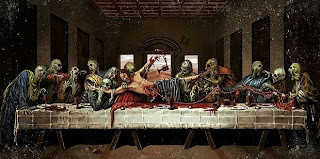 I realize that this post, well, at least the image that accompanies this post, will be off-putting if not repulsive for many evangelical Christian readers, or at least some of them, but try to withhold judgment for a few moments.
I realize that this post, well, at least the image that accompanies this post, will be off-putting if not repulsive for many evangelical Christian readers, or at least some of them, but try to withhold judgment for a few moments.
I don’t know the origins of the image that is an obvious zombie reinterpretation on Da Vinci’s famous Last Supper painting. When I saw it several thoughts immediately came to mind. The first I have already expressed, the probability that many conservative Christians will be repulsed by the image. But another thought I had was to remember one of the “hard sayings” of Jesus, one that his disciples and the crowds of the first century had a difficult time understanding and accepting, and differing interpretations of it continue to be a point of minor division among Protestants and Catholics.
In the Gospel of John, chapter 6 Jesus presents a lengthy discussion about spiritual food to a hungry crowd. After referring to himself as the bread of life he says, “this bread is my flesh, which I will give for the life of the world,” and as if this wasn’t difficult enough for the crowd to accept with its seeming reference to cannibalism Jesus continued and said “I tell you the truth, unless you eat the flesh of the Son of Man and drink his blood, you have no life in you.”
Protestants and Catholics have interpreted these words as a reference to communion or the Lord’s Supper, with Protestants preferring a strong emphasis on symbolism as an ordinance and Catholics holding to a sacramental view of communion’s bread and wine as a transformation into the literal flesh and blood of Christ. While I appreciate aspects of both views it is not my purpose to enter into these kinds of discussions, but instead to draw attention to the sometimes macabre and mystical teachings of Jesus. In my view Protestants tend to downplay or reinterpret such teachings which often results in a sanitized portrait of Christ. But if we put ourselves in the sandals of Jesus’s first century audience who heard these words, how scandalized they must have been! Recall as well that one of the charges the Romans hurled at the early Christians was that they were a cannibalistic cult that feasted on the flesh and blood of its allegedly resurrected founder. It seems that a number of segments of early first century Palestine struggled with Jesus’s teaching here, whether his closest followers, the curious crowds, the Jews, or the Gentiles of Rome.
I also wonder whether Christians, especially American evangelicals, have not so turned Jesus and what he stands for into a commodity for our culture that Jesus is consumed according to our consumer appetites almost as ravenously as humans are devoured in any number of zombie films. We seem to be eating Jesus in a variety of ways, but are they the ways which he envisioned for his followers?
The points I’d like to emphasize with this image are a reminder of the often controversial nature of Jesus’s teachings even among his followers, and that at times he even seemed to go out of his way to be provocative. In addition, is there not some sense in which the zombie supper graphically illustrates an aspect of the Christian participation with Jesus in a mystical identification with him through the consumption of his flesh and blood however communion is interpreted? And what about Jesus as a consumer image for the church?
If these thoughts have any merit, then reflections on a zombie supper not only fit in well with the Halloween season, but also permit different perspectives on a sometimes macabre faith. Perhaps this image should not be as off-putting as we might first imagine.
Update: See the related issues in relation to Italian zombie films at The Vault of Horror, and my previous post looking at “Zombie Crawl and Zombie Jesus.”





Fascinating post. I certainly appreciate your insight on the whole issue of Christ’s “consumption” in our own present-day culture, and the way He and His teachings are readily appropriated for any number of purposes.
B-Sol, thanks for stopping by and leaving the comment. You’ll see that as a result of reading your fine related post on your blog that I updated my post to include a link. I perused your site yesterday and enjoyed getting caught up. It’s good to see someone thinking through topics in a similar vein.
I thoroughly enjoyed your article. Very studious of you and deeply insightful in pointing out the very same controversial nature of the man himself as a parallel in the illustration!
Corvis Nocturnum, author